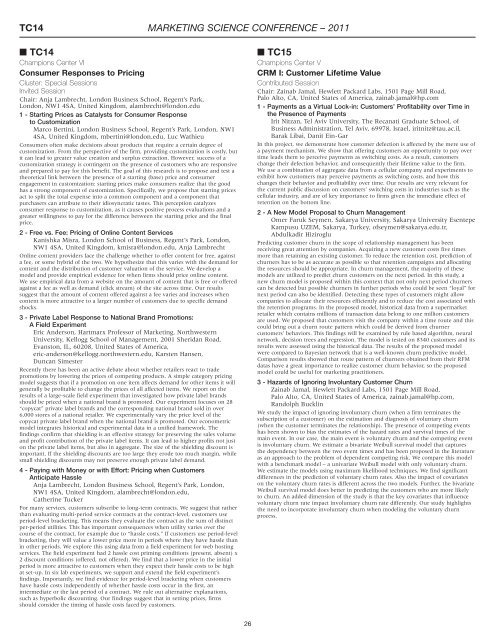Conference Sessions - Jesse H. Jones Graduate School of ...
Conference Sessions - Jesse H. Jones Graduate School of ...
Conference Sessions - Jesse H. Jones Graduate School of ...
Create successful ePaper yourself
Turn your PDF publications into a flip-book with our unique Google optimized e-Paper software.
TC14<br />
■ TC14<br />
Champions Center VI<br />
Consumer Responses to Pricing<br />
Cluster: Special <strong>Sessions</strong><br />
Invited Session<br />
Chair: Anja Lambrecht, London Business <strong>School</strong>, Regent’s Park,<br />
London, NW1 4SA, United Kingdom, alambrecht@london.edu<br />
1 - Starting Prices as Catalysts for Consumer Response<br />
to Customization<br />
Marco Bertini, London Business <strong>School</strong>, Regent’s Park, London, NW1<br />
4SA, United Kingdom, mbertini@london.edu, Luc Wathieu<br />
Consumers <strong>of</strong>ten make decisions about products that require a certain degree <strong>of</strong><br />
customization. From the perspective <strong>of</strong> the firm, providing customization is costly, but<br />
it can lead to greater value creation and surplus extraction. However, success <strong>of</strong> a<br />
customization strategy is contingent on the presence <strong>of</strong> customers who are responsive<br />
and prepared to pay for this benefit. The goal <strong>of</strong> this research is to propose and test a<br />
theoretical link between the presence <strong>of</strong> a starting (base) price and consumer<br />
engagement in customization: starting prices make consumers realize that the good<br />
has a strong component <strong>of</strong> customization. Specifically, we propose that starting prices<br />
act to split the total expense into a common component and a component that<br />
purchasers can attribute to their idiosyncratic tastes. This perception catalyzes<br />
consumer response to customization, as it causes positive process evaluations and a<br />
greater willingness to pay for the difference between the starting price and the final<br />
price.<br />
2 - Free vs. Fee: Pricing <strong>of</strong> Online Content Services<br />
Kanishka Misra, London <strong>School</strong> <strong>of</strong> Business, Regent’s Park, London,<br />
NW1 4SA, United Kingdom, kmisra@london.edu, Anja Lambrecht<br />
Online content providers face the challenge whether to <strong>of</strong>fer content for free, against<br />
a fee, or some hybrid <strong>of</strong> the two. We hypothesize that this varies with the demand for<br />
content and the distribution <strong>of</strong> customer valuation <strong>of</strong> the service. We develop a<br />
model and provide empirical evidence for when firms should price online content.<br />
We use empirical data from a website on the amount <strong>of</strong> content that is free or <strong>of</strong>fered<br />
against a fee as well as demand (click stream) <strong>of</strong> the site across time. Our results<br />
suggest that the amount <strong>of</strong> content <strong>of</strong>fered against a fee varies and increases when<br />
content is more attractive to a larger number <strong>of</strong> customers due to specific demand<br />
shocks.<br />
3 - Private Label Response to National Brand Promotions:<br />
A Field Experiment<br />
Eric Anderson, Hartmarx Pr<strong>of</strong>essor <strong>of</strong> Marketing, Northwestern<br />
University, Kellogg <strong>School</strong> <strong>of</strong> Management, 2001 Sheridan Road,<br />
Evanston, IL, 60208, United States <strong>of</strong> America,<br />
eric-anderson@kellogg.northwestern.edu, Karsten Hansen,<br />
Duncan Simester<br />
Recently there has been an active debate about whether retailers react to trade<br />
promotions by lowering the prices <strong>of</strong> competing products. A simple category pricing<br />
model suggests that if a promotion on one item affects demand for other items it will<br />
generally be pr<strong>of</strong>itable to change the prices <strong>of</strong> all affected items. We report on the<br />
results <strong>of</strong> a large-scale field experiment that investigated how private label brands<br />
should be priced when a national brand is promoted. Our experiment focuses on 28<br />
“copycat” private label brands and the corresponding national brand sold in over<br />
6,000 stores <strong>of</strong> a national retailer. We experimentally vary the price level <strong>of</strong> the<br />
copycat private label brand when the national brand is promoted. Our econometric<br />
model integrates historical and experimental data in a unified framework. The<br />
findings confirm that shielding is an effective strategy for preserving the sales volume<br />
and pr<strong>of</strong>it contribution <strong>of</strong> the private label items. It can lead to higher pr<strong>of</strong>its not just<br />
on the private label items, but also in aggregate. The size <strong>of</strong> the shielding discount is<br />
important. If the shielding discounts are too large they erode too much margin, while<br />
small shielding discounts may not preserve enough private label demand.<br />
4 - Paying with Money or with Effort: Pricing when Customers<br />
Anticipate Hassle<br />
Anja Lambrecht, London Business <strong>School</strong>, Regent’s Park, London,<br />
NW1 4SA, United Kingdom, alambrecht@london.edu,<br />
Catherine Tucker<br />
For many services, customers subscribe to long-term contracts. We suggest that rather<br />
than evaluating multi-period service contracts at the contract-level, customers use<br />
period-level bracketing. This means they evaluate the contract as the sum <strong>of</strong> distinct<br />
per-period utilities. This has important consequences when utility varies over the<br />
course <strong>of</strong> the contract, for example due to “hassle costs.” If customers use period-level<br />
bracketing, they will value a lower price more in periods where they have hassle than<br />
in other periods. We explore this using data from a field experiment for web hosting<br />
services. The field experiment had 2 hassle cost priming conditions (present, absent) x<br />
2 discount conditions (<strong>of</strong>fered, not <strong>of</strong>fered). We find that a lower price in the initial<br />
period is more attractive to customers when they expect their hassle costs to be high<br />
at set-up. In six lab experiments, we support and extend the field experiment’s<br />
findings. Importantly, we find evidence for period-level bracketing when customers<br />
have hassle costs independently <strong>of</strong> whether hassle costs occur in the first, an<br />
intermediate or the last period <strong>of</strong> a contract. We rule out alternative explanations,<br />
such as hyperbolic discounting. Our findings suggest that in setting prices, firms<br />
should consider the timing <strong>of</strong> hassle costs faced by customers.<br />
MARKETING SCIENCE CONFERENCE – 2011<br />
26<br />
■ TC15<br />
Champions Center V<br />
CRM I: Customer Lifetime Value<br />
Contributed Session<br />
Chair: Zainab Jamal, Hewlett Packard Labs, 1501 Page Mill Road,<br />
Palo Alto, CA, United States <strong>of</strong> America, zainab.jamal@hp.com<br />
1 - Payments as a Virtual Lock-in: Customers’ Pr<strong>of</strong>itability over Time in<br />
the Presence <strong>of</strong> Payments<br />
Irit Nitzan, Tel Aviv University, The Recanati <strong>Graduate</strong> <strong>School</strong>, <strong>of</strong><br />
Business Administration, Tel Aviv, 69978, Israel, iritnitz@tau.ac.il,<br />
Barak Libai, Danit Ein-Gar<br />
In this project, we demonstrate how customer defection is affected by the mere use <strong>of</strong><br />
a payment mechanism. We show that <strong>of</strong>fering customers an opportunity to pay over<br />
time leads them to perceive payments as switching costs. As a result, customers<br />
change their defection behavior, and consequently their lifetime value to the firm.<br />
We use a combination <strong>of</strong> aggregate data from a cellular company and experiments to<br />
exhibit how customers may perceive payments as switching costs, and how this<br />
changes their behavior and pr<strong>of</strong>itability over time. Our results are very relevant for<br />
the current public discussion on customers’ switching costs in industries such as the<br />
cellular industry, and are <strong>of</strong> key importance to firms given the immediate effect <strong>of</strong><br />
retention on the bottom line.<br />
2 - A New Model Proposal to Churn Management<br />
Omer Faruk Seymen, Sakarya University, Sakarya University Esentepe<br />
Kampusu UZEM, Sakarya, Turkey, <strong>of</strong>seymen@sakarya.edu.tr,<br />
Abdulkadir Hiziroglu<br />
Predicting customer churn in the scope <strong>of</strong> relationship management has been<br />
receiving great attention by companies. Acquiring a new customer costs five times<br />
more than retaining an existing customer. To reduce the retention cost, prediction <strong>of</strong><br />
churners has to be as accurate as possible so that retention campaigns and allocating<br />
the resources should be appropriate. In churn management, the majority <strong>of</strong> these<br />
models are utilized to predict churn customers on the next period. In this study, a<br />
new churn model is proposed within this context that not only next period churners<br />
can be detected but possible churners in further periods who could be seen “loyal” for<br />
next period can also be identified. Detecting these types <strong>of</strong> customers might allow<br />
companies to allocate their resources efficiently and to reduce the cost associated with<br />
the retention programs. In the proposed model, historical data from a supermarket<br />
retailer which contains millions <strong>of</strong> transaction data belong to one million customers<br />
are used. We proposed that customers visit the company within a time route and this<br />
could bring out a churn route pattern which could be derived from churner<br />
customers’ behaviors. This findings will be examined by rule based algorithm, neural<br />
network, decision trees and regression. The model is tested on 8340 customers and its<br />
results were assessed using the historical data. The results <strong>of</strong> the proposed model<br />
were compared to Bayesian network that is a well-known churn predictive model.<br />
Comparison results showed that route pattern <strong>of</strong> churners obtained from their RFM<br />
datas have a great importance to realize customer churn behavior, so the proposed<br />
model could be useful for marketing practitioners.<br />
3 - Hazards <strong>of</strong> Ignoring Involuntary Customer Churn<br />
Zainab Jamal, Hewlett Packard Labs, 1501 Page Mill Road,<br />
Palo Alto, CA, United States <strong>of</strong> America, zainab.jamal@hp.com,<br />
Randolph Bucklin<br />
We study the impact <strong>of</strong> ignoring involuntary churn (when a firm terminates the<br />
subscription <strong>of</strong> a customer) on the estimation and diagnosis <strong>of</strong> voluntary churn<br />
(when the customer terminates the relationship). The presence <strong>of</strong> competing events<br />
has been shown to bias the estimates <strong>of</strong> the hazard rates and survival times <strong>of</strong> the<br />
main event. In our case, the main event is voluntary churn and the competing event<br />
is involuntary churn. We estimate a bivariate Weibull survival model that captures<br />
the dependency between the two event times and has been proposed in the literature<br />
as an approach to the problem <strong>of</strong> dependent competing risk. We compare this model<br />
with a benchmark model – a univariate Weibull model with only voluntary churn.<br />
We estimate the models using maximum likelihood techniques. We find significant<br />
differences in the prediction <strong>of</strong> voluntary churn rates. Also the impact <strong>of</strong> covariates<br />
on the voluntary churn rates is different across the two models. Further, the bivariate<br />
Weibull survival model does better in predicting the customers who are more likely<br />
to churn. An added dimension <strong>of</strong> the study is that the key covariates that influence<br />
voluntary churn rate impact involuntary churn rate differently. Our study highlights<br />
the need to incorporate involuntary churn when modeling the voluntary churn<br />
process.

















